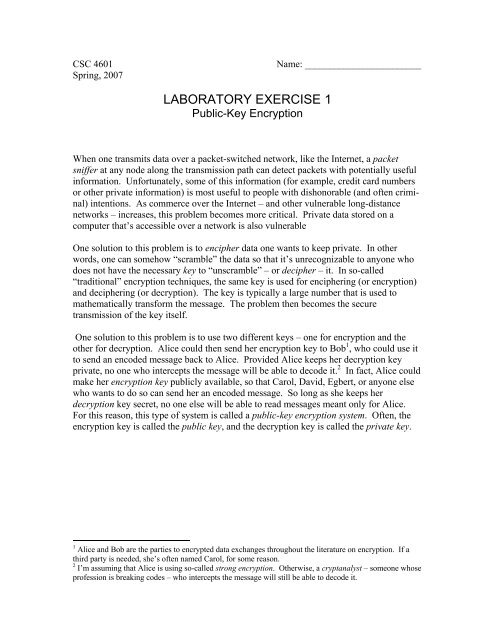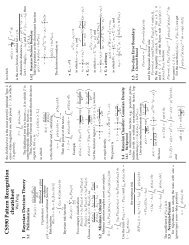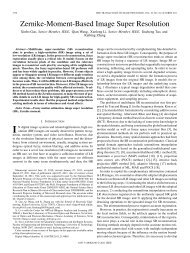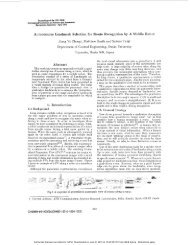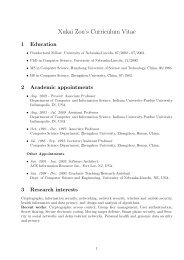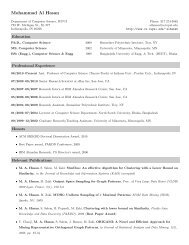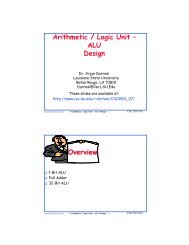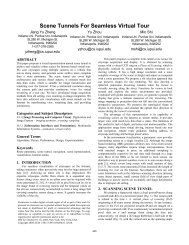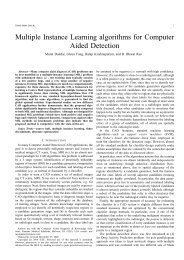Lab1 due on May 4, 2007. - Computer & Information Science @ IUPUI
Lab1 due on May 4, 2007. - Computer & Information Science @ IUPUI
Lab1 due on May 4, 2007. - Computer & Information Science @ IUPUI
You also want an ePaper? Increase the reach of your titles
YUMPU automatically turns print PDFs into web optimized ePapers that Google loves.
CSC 4601 Name: ________________________<br />
Spring, 2007<br />
LABORATORY EXERCISE 1<br />
Public-Key Encrypti<strong>on</strong><br />
When <strong>on</strong>e transmits data over a packet-switched network, like the Internet, a packet<br />
sniffer at any node al<strong>on</strong>g the transmissi<strong>on</strong> path can detect packets with potentially useful<br />
informati<strong>on</strong>. Unfortunately, some of this informati<strong>on</strong> (for example, credit card numbers<br />
or other private informati<strong>on</strong>) is most useful to people with dish<strong>on</strong>orable (and often criminal)<br />
intenti<strong>on</strong>s. As commerce over the Internet – and other vulnerable l<strong>on</strong>g-distance<br />
networks – increases, this problem becomes more critical. Private data stored <strong>on</strong> a<br />
computer that’s accessible over a network is also vulnerable<br />
One soluti<strong>on</strong> to this problem is to encipher data <strong>on</strong>e wants to keep private. In other<br />
words, <strong>on</strong>e can somehow “scramble” the data so that it’s unrecognizable to any<strong>on</strong>e who<br />
does not have the necessary key to “unscramble” – or decipher – it. In so-called<br />
“traditi<strong>on</strong>al” encrypti<strong>on</strong> techniques, the same key is used for enciphering (or encrypti<strong>on</strong>)<br />
and deciphering (or decrypti<strong>on</strong>). The key is typically a large number that is used to<br />
mathematically transform the message. The problem then becomes the secure<br />
transmissi<strong>on</strong> of the key itself.<br />
One soluti<strong>on</strong> to this problem is to use two different keys – <strong>on</strong>e for encrypti<strong>on</strong> and the<br />
other for decrypti<strong>on</strong>. Alice could then send her encrypti<strong>on</strong> key to Bob 1 , who could use it<br />
to send an encoded message back to Alice. Provided Alice keeps her decrypti<strong>on</strong> key<br />
private, no <strong>on</strong>e who intercepts the message will be able to decode it. 2 In fact, Alice could<br />
make her encrypti<strong>on</strong> key publicly available, so that Carol, David, Egbert, or any<strong>on</strong>e else<br />
who wants to do so can send her an encoded message. So l<strong>on</strong>g as she keeps her<br />
decrypti<strong>on</strong> key secret, no <strong>on</strong>e else will be able to read messages meant <strong>on</strong>ly for Alice.<br />
For this reas<strong>on</strong>, this type of system is called a public-key encrypti<strong>on</strong> system. Often, the<br />
encrypti<strong>on</strong> key is called the public key, and the decrypti<strong>on</strong> key is called the private key.<br />
1 Alice and Bob are the parties to encrypted data exchanges throughout the literature <strong>on</strong> encrypti<strong>on</strong>. If a<br />
third party is needed, she’s often named Carol, for some reas<strong>on</strong>.<br />
2 I’m assuming that Alice is using so-called str<strong>on</strong>g encrypti<strong>on</strong>. Otherwise, a cryptanalyst – some<strong>on</strong>e whose<br />
professi<strong>on</strong> is breaking codes – who intercepts the message will still be able to decode it.
page 2<br />
In this lab, you will be working with a simplified – and not very secure – versi<strong>on</strong> of <strong>on</strong>e<br />
of the most popular public-key systems: the RSA public-key encrypti<strong>on</strong> system. 3 Like all<br />
public-key systems, the keys are derived using a “trapdoor” operati<strong>on</strong> – an operati<strong>on</strong> that<br />
is easy to do but difficult to “undo.” In RSA, this operati<strong>on</strong> is the multiplicati<strong>on</strong> of two<br />
large prime numbers: it is easy and fast to multiply the two numbers together, but it is<br />
significantly more difficult and time c<strong>on</strong>suming to factor the resulting number back into<br />
its prime comp<strong>on</strong>ents. In this lab experience, you will be using relatively small primes<br />
(<strong>on</strong>ly three digits) to see how this system works.<br />
To explore this system in more depth, you will be exchanging encrypted messages with a<br />
partner. Choose your partner now.<br />
1. Launch Microsoft Excel and open the spreadsheet<br />
rsa.xls.<br />
You may see a warning message informing you that the workbook c<strong>on</strong>tains macros.<br />
Since you will not need these macros to use the workbook (they are left over from an<br />
older and less efficient versi<strong>on</strong> of this lab), click <strong>on</strong> the Disable Macros butt<strong>on</strong>.<br />
2. This spreadsheet makes use of some specialized functi<strong>on</strong>s that are not part of the<br />
standard functi<strong>on</strong> set in Microsoft Excel. However, they are included in an extra set<br />
of functi<strong>on</strong>s called the Analysis Toolpak. From the Tools menu, choose Add-Ins….<br />
In the dialogue box, click <strong>on</strong> the check box to the left of the entry Analysis<br />
Toolpak. When a checkmark appears, click <strong>on</strong> OK.<br />
3. If necessary, click <strong>on</strong> the tab for the Key Selecti<strong>on</strong> worksheet. Use a random<br />
process to choose two different prime numbers p and q between 137 and 311<br />
(displayed in a list in cells g5:I15). Enter these primes in cells B6 and B7. Be sure<br />
that cells C6 and C7 both display the message “OK”. The spreadsheet automatically<br />
computes the modulus (the product p*q) in cell B8 and the Euler totient (the product<br />
(p-1)*(q-1)) in cell B9. Note that the Euler totient would be difficult to determine<br />
from the modulus by itself; <strong>on</strong>e needs to know the two primes. Write your two<br />
primes, your modulus, and your Euler totient below:<br />
p: _______ q: ___________ modulus: ___________<br />
Euler totient: ______________<br />
3 Named for its inventors – R<strong>on</strong> Rivest, Adi Shamir and Le<strong>on</strong>ard Adelman.
page 3<br />
4. Choose a small number (no more that two digits) that has no factors (except 1) in<br />
comm<strong>on</strong> with the Euler totient. Enter this number as your public key and enter it in<br />
cell B15. If cell C15 displays the message Invalid Public Key, you need to select a<br />
different public key. When you have chosen a valid public key, the message OK will<br />
appear in cell C15. The spreadsheet will automatically compute your private key in<br />
cell B20. The private key is chosen so that (Public Key)*(Private Key) leaves a<br />
remainder of <strong>on</strong>e when divided by the Euler totient. (This would not be possible if<br />
the private had a factor other than 1 in comm<strong>on</strong> with the Euler totient.) Write your<br />
public and private keys below:<br />
Public key: _____________<br />
Private key: _______________<br />
5. Once both you and your partner have each created a modulus and pair of keys, you<br />
are ready to exchange encrypted messages. Give your modulus and public key to<br />
your partner. Do not give your partner your private key or Euler totient. In return,<br />
your partner will give you her/his public key and modulus.<br />
6. Click <strong>on</strong> the tab for the Encoding worksheet. Enter your partner’s modulus and<br />
public key in cells B6 and B7. Write these values below:<br />
Partner’s modulus: _________________<br />
Partner’s public key: __________________<br />
7. Enter a message in cell B11. This message should c<strong>on</strong>sist of a string of fifteen or<br />
more CAPITAL LETTERS with no spaces or punctuati<strong>on</strong> marks. The spreadsheet<br />
will encipher <strong>on</strong>ly the first fifteen letters of your message. Your message could be a<br />
short phrase or sentence, your mother’s name or your pet iguana’s name. For<br />
example, I used RUTHJULIABENHAM and PLEASEHELPMENOW to test this<br />
spreadsheet. Note that a message to be enciphered is usually called plaintext. The<br />
enciphered form of the message is called the ciphertext.
page 4<br />
8. The enciphered form of the message (the ciphertext) should appear in cell B13. (This<br />
may take a few sec<strong>on</strong>ds.) The spreadsheet determines the ciphertext as follows:<br />
• Split the plaintext up into blocks of three letters (called trigraphs).<br />
• Obtain a numeric representati<strong>on</strong> for each letter based <strong>on</strong> its positi<strong>on</strong> in the<br />
alphabet (A→0, B→1, etc.).<br />
• Compute a numeric code for each trigraph using the formula<br />
(First Letter Code) * 26 2 + (Sec<strong>on</strong>d Letter Code) * 26 + (Third Letter code).<br />
For the mathematically inclined, this is interpreting each trigraph as a number in<br />
base twenty-six.<br />
• Encipher each plaintext trigraph code by computing<br />
(Plaintext trigraph code) Public Key , dividing the result by the Modulus and<br />
taking the remainder.<br />
• C<strong>on</strong>vert each enciphered trigraph code into a quadragraph – a block of four<br />
letters – as follows:<br />
Divide the code by 26 3. The quotient is the code for the first letter of the<br />
quadragraph. The spreadsheet uses the remainder to get codes for the other<br />
three letters.<br />
Divide the remainder from the first step by 26 2 . The quotient is the code for<br />
the sec<strong>on</strong>d letter. The spreadsheet uses the remainder to get the codes for the<br />
other two letters.<br />
Divide the remainder from the sec<strong>on</strong>d step by 26. The quotient is the code for<br />
the third letter and the remainder is the code for the fourth letter.<br />
For the mathematically inclined, this quadragraph calculati<strong>on</strong> determines the<br />
representati<strong>on</strong> of the enciphered message as a four-digit number in base<br />
twenty-six (using the letters of the alphabet as our digits).
Some of the details of this calculati<strong>on</strong> appear in cells A16:K38 of the Encoding<br />
worksheet. Enter the plaintext and ciphertext below. Show the steps of the<br />
c<strong>on</strong>versi<strong>on</strong> process in the table.<br />
Plaintext: _____________________________________<br />
page 5<br />
Plaintext Ciphertext<br />
Trigraph Trigraph Code Enciphered Code Quadragraph<br />
Ciphertext: ___________________________________<br />
9. Give the ciphertext (but not the plaintext) to your partner. In return, your partner will<br />
give you a ciphertext message. Record the ciphertext message from your partner<br />
below. In the rest of this exercise, you will be deciphering this message.<br />
Ciphertext from partner: ______________________________<br />
10. Click <strong>on</strong> the tab for the Decoding worksheet. Enter your modulus and your private<br />
key in cells B6 and B7 of this worksheet. Enter the ciphertext you received from<br />
your partner as the “Encrypted Message” in cell B13. The deciphering process is<br />
similar to the enciphering process:<br />
• Split the ciphertext up into quadragraphs (instead of trigraphs).<br />
• Obtain the numeric representati<strong>on</strong> for each letter and compute a numeric code for<br />
each trigraph using the formula<br />
(First Letter Code) * 26 3 + (Sec<strong>on</strong>d Letter Code) * 26 2 +<br />
(Third Letter Code) * 26 + (Fourth Letter Code).<br />
Encipher each ciphertext quadragraph code by computing<br />
(Ciphertext quadragraph code) Private Key ,<br />
dividing the result by the Modulus and taking the remainder
page 6<br />
• C<strong>on</strong>vert each deciphered quadragraph code into a trigraph.<br />
Divide the code by 26 2 . The quotient is the code for the first letter.<br />
Divide the remainder from the first step by 26. The quotient will be the code<br />
for the sec<strong>on</strong>d letter and the remainder the code for the third.<br />
Note that deciphering uses the private key in place of the public key. Some of the<br />
details of this calculati<strong>on</strong> appear in cells A19:D23 of the Decoding Worksheet. The<br />
deciphered message should appear in cell B13. Record the results of each<br />
deciphering step in the table below.<br />
Ciphertext Plaintext<br />
Quadragraph Quadragraph<br />
Code<br />
Now, write the deciphered message (plaintext) below.<br />
Deciphered message: __________________________<br />
Deciphered Code Deciphered<br />
Trigraph


